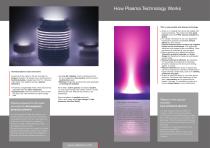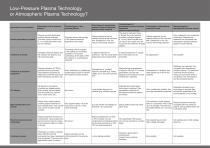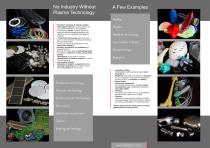
Catalog excerpts

Plasma Surface Technology
Open the catalog to page 1
Plasma Technology – New Surfaces on Every Material What are the uses of technical plasma? Plasma: the fourth state of matter Technical plasma is capable of generating almost any surface characteristics to any materials: Almost any substance is solid (frozen) when the temperature is low enough. When energy is added (heating), it becomes liquid. When heated further, it becomes gaseous. When even more energy is added to a gas, it causes electrons to separate from molecules and atoms. The result is a plasma. Plasma removes organic residue from all surfaces. Plasma treatment increases surface...
Open the catalog to page 2
How Plasma Technology Works This is only possible with plasma technology There is no material that cannot be treated with technical plasma. This means that non-polar plastics and even PTFE become suitable for gluing. It is usually necessary to use very aggressive chemicals to achieve comparable surface effects by other means. Plasma treatment does not have any negative impact on the environment. The aggressive media are only present within the plasma. Once the plasma is switched off, they are gone. Plasma treatment only affects the surface. Thermally sensitive materials and living things...
Open the catalog to page 3
Plasma Systems Atmospheric Pressure Plasma System APC 500 (Corona Method) Diener electronic covers all your needs Diener electronic offers solutions to any surface problem. While our competitors specialise in specific aspects of plasma technology, Diener electronic has experience and offers answers for all fields where surfaces are treated. High-voltage line ...or we invent a solution for you Diener electronic was the first manufacturer to mass produce low-pressure systems with lowfrequency (LF) excitation, which dominate in many areas of technology today. If there is no standard-system to...
Open the catalog to page 4
Atmospheric Pressure Plasma System Plasma Beam (Active gas jet Method) A gas discharge is ignited between a central electrode and an insulated ring electrode. A plasma is excited in the stream of gas flowing through. The plasma is blown out through the nozzle. high. The plasma can therefore generally be guided over the substrate quickly. Handling and robotics systems make it possible to rapidly treat curved surfaces of any dimensions. There is no high voltage in the plasma jet. Metallic substrates can also be treated. The temperature is relatively high. Thermally sensitive substrates can...
Open the catalog to page 5
Low-Pressure Plasma Technology or Atmospheric Plasma Technology? Disadvantages of atmospheric-pressure plasma PlasmaJet (plasma nozzle method) The plasma treatment track is limited due to the plasma excitation principle (approx. 8-12 mm). More nozzles must be used or the nozzle must be moved for the treatment of larger objects. Advantages of low-pressure plasma Disadvantages of lowpressure plasma Advantages of atmosphericpressure plasma PlasmaJet (plasma nozzle method) Plasma generation in general Plasma is evenly distributed inside a plasma chamber. Chamber volume varies from 0.1 to 12,600...
Open the catalog to page 6
No Industry Without Plasma Technology Precision cleaning of organic residue with oxygen plasma is a precondition for any further treatment in all industries. In the field of optics, scratch-proof and optically active coatings (polarising, antireflective, etc.) are applied using plasma coating. In precision technology, gear parts are given a wear-resistant coating and bearings become epilamized. There are numerous applications in the electronics industry: Etching, structuring, ion implanting of semiconductors Etching of masks used in photolithography for applying conductor tracks, photoresist...
Open the catalog to page 7
Areas of Application: Cleaning Residue on untreated surfaces causes coatings to drip off. Wetting is optimal after plasma cleaning. Activation PWIS = Paint-Wetting Impairment Substances prevent sufficient paint adhesion. The cross-cut test brings this to light Perfect paint adhesion on PWIS-free surface after plasma treatment Plasma precision cleaning: A prerequisite for perfect adhesion Organic residue can be found on even the cleanest surfaces. Release agent residue is present on components that have just rolled off the production line, and even short-term exposure to the surrounding air...
Open the catalog to page 8
Etching Untreated surface Coating Process Plasma-treated surface Plastics and semi-conductors Plasma technology makes anisotropic and isotropic etching possible: Isotropic etching by means of chemical multi directional etching, anisotropic etching by means of physical etching (ion etching approach the surface approx. from one direction), as well as (RIE = Reactive Ion Etching). Isotropic etching is made possible by polymeric degradation and chemical reaction on organic materials. Anisotropic etching by ion bombardment is generally effective on any substrate. Applications for isotropic...
Open the catalog to page 9
Our Services Plasma Systems High level of competence in plasma systems • Diener electronic produces all systems entirely in- • Diener electronic produces a complete range of atmospheric and low-pressure systems in all sizes • Our products do not come „off-the-shelf". Instead, our production process is designed to ensure a tailor-made solution for every client and every • Our systems are used in every industry and for all applications where plasma technology is required. • Diener electronic is the market leader in the field of low-pressure plasma systems. • Diener electronic introduced...
Open the catalog to page 10
Surface Treatment Services Do you only rarely have parts which need to be treated with plasma? Is the shape of your parts so complicated that it is difficult to find a system that would fit your budget? Do you lack a clean room for treating your parts? Would you like to leave the plasma treatment of your parts to the experts? You are not yet ready to invest in your own plasma technology Your own capacity for plasma treatment is not sufficient For all of these cases we offer in-house surface treatment. Experienced and trained staff are available to ensure optimum surface quality of your parts...
Open the catalog to page 11All Diener electronic GmbH & Co. KG catalogs and technical brochures
-
RF 300
2 Pages
-
RF 100
2 Pages
-
DLC
3 Pages
-
Tetra 150
6 Pages
-
Tetra 100
6 Pages
-
Parylene P300
2 Pages
-
Parylene P260
2 Pages
-
Parylene P120D
2 Pages
-
Parylene P30
2 Pages
-
Parylene P6
2 Pages
-
Parylene
3 Pages
-
Surface treatment Service
6 Pages
-
Atto/Zepto
2 Pages
-
APC 500
4 Pages
-
MWG1200
2 Pages
-
LFG5000
2 Pages
-
LFG3000
2 Pages
-
LFG1000
2 Pages
-
LFG500
5 Pages
-
PlasmaBeamMini
2 Pages
-
PlasmaBeamDuo
6 Pages
-
PlasmaBeam PC
6 Pages
-
Special systems
36 Pages
-
TETRA 30
6 Pages
-
PlasmaBeam
6 Pages
-
TETRA
9 Pages
-
NANO
2 Pages
-
PICO
2 Pages
-
FEMTO
2 Pages
-
Tetra 8
1 Pages
-
PLASMA APC 500
1 Pages



































